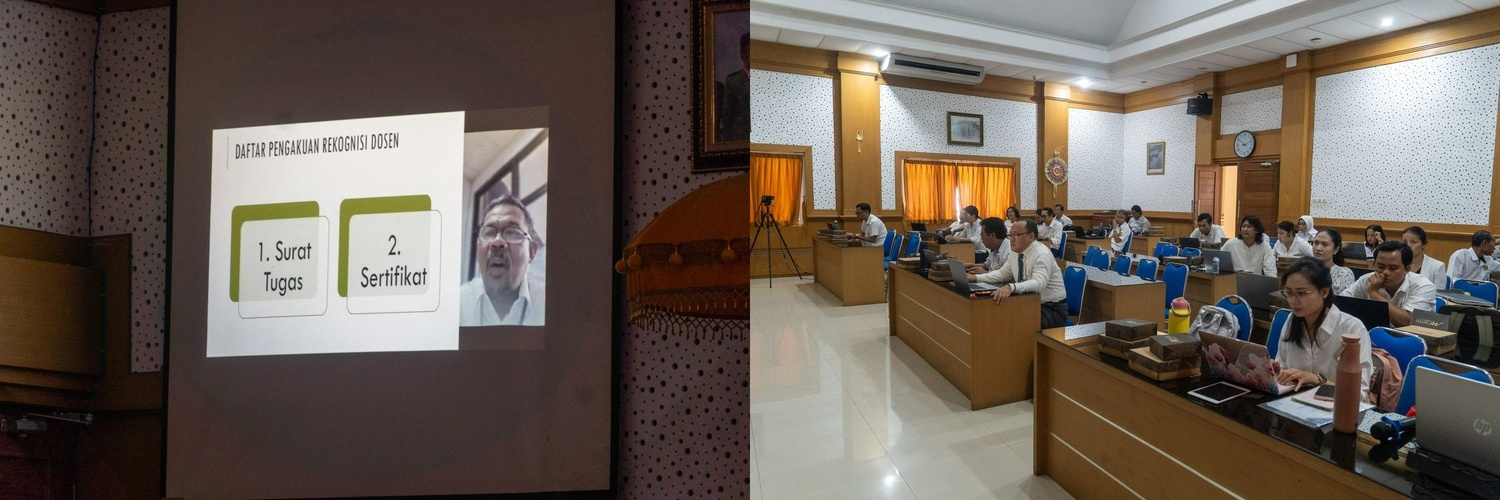Lecturer in the Japanese Literature Study Program, Faculty of Humanities, Udayana University, Earned a Doctoral Degree with the Topic of Japanese Relative Clause Typology
The Linguistics Doctoral Program, Faculty of Humanities, Udayana University, held its Dissertation Defense on Thursday, August 28, 2025, in the Ir. Soekarno Room, Poerbatjaraka Building, Faculty of Humanities, Udayana University. Ngurah Indra Pradhana, S.S., M.Hum., a lecturer in the Japanese Literature Program, Faculty of Humanities, Udayana University, successfully defended his dissertation and graduated with a GPA of 3.58, with a "Very Satisfactory" distinction. He is the 271st graduate of the Faculty of Humanities, Udayana University, and the 276th graduate of the Linguistics Doctoral Program, Faculty of Humanities, Udayana University.
The Chair of the Examining Team and Co-Promoter I for this Doctoral Promotion Examination was Prof. Dr. Ketut Artawa, M.A., accompanied by Prof. Drs. I Nyoman Udayana, M.Litt., Ph.D. as the promoter and Dr. Ketut Widya Purnawati, S.S., M.Hum. as Co-promoter II. Meanwhile, the examining team in the examination session was as follows: Prof. Dr. I Wayan Simpen, M.Hum., Prof. Dr. Ni Luh Sutjiati Beratha, M.A., Prof. Dr. I Wayan Pastika, M.S., Dr. I Gusti Agung Istri Aryani, S.S., M.Hum., and Dr. Dra. Lien Darlina, M.Hum. as External Examiner from Bali State Polytechnic. In this defense, promovendus presented a dissertation entitled "Typology of Japanese Relative Clauses".
In his presentation, Promovendus explained that relative clauses are subordinate clauses. These clauses are also commonly called embedded clauses because they are attached to a constituent or a higher-order element. Japanese relative clauses have a construction that differs from other languages in that they are placed before the noun they modify. This became the basis for Promovendus's research. The research data sources were taken from Japanese texts containing relative clauses, such as the Sukasuki website and official Japanese-language websites (newspapers and magazines). In his dissertation, Promovendus explained the typological features of Japanese that are characteristic of the language. These features are linked to the basic structure, strategies, and meanings contained in Japanese relative clauses.
Furthermore, there are several components that form the grammatical structure of relative clauses in Japanese: word order that has a prenominal relative clause type (Keenan, 1985), particles that act as post-positions placed after the word being described, the relative clause predicate as an agentive language, an antecedent or noun explained in the relative clause, as well as other features that construct Japanese relative clauses (demonstratives or demonstratives, peripheral argument markers, non-spatial setting markers, negation markers, formality level markers, passive and causative markers, transitive and intransitive markers, and modality markers). The general structure of relative clauses in Japanese itself consists of “Subject Clause [Subject + Object + Verb] + Antecedent [Noun]”. This sentence pattern is used when the subordinate clause functions to explain the antecedent (noun).
There are two variations in the order of Japanese relative clauses: one based on the emphasis on the antecedent's function in the relative clause and the other based on the type of predicate describing the antecedent. The antecedent is the head noun placed after the relative clause. Promovendus also explained the classification of relative clauses, which are divided into two categories (Iori, 2012): uchi no kankei (internal relationship) and soto no kankei (external relationship). Within internal relationships, Japanese relative clauses are divided into three types: restrictive, non-restrictive, and ambiguous. Meanwhile, in external relationships, they are divided into two types: independent and dependent. Promovendus stated that this research yields several innovations in the field of microlinguistics, particularly the study of Japanese relative clause typology to discover patterns of relationships between basic structure, strategy, and meaning in Japanese relative clauses, as well as those related to the characteristics of Japanese relative clauses, including syntax.
Furthermore, this research also complements the understanding of the structure of relative clauses that have not been put forward by Dixon and Comrie which are characteristics of relative clauses in Japanese. Another discovery is a pseudo-relative marker in the form of a combination of particles with verbs such as the words to iu 'that is said', ni kan suru 'related to', and others. From a semantic perspective, two types of meanings were also found, namely internal meaning and external meaning. Closing the defense, Prof. Drs. I Nyoman Udayana, M.Litt., Ph.D. as the promoter gave a speech and expressed his gratitude to the Examining Team who accompanied the course of this exam. He also appreciated the diligence and tenacity of the prospective student. He encouraged the prospective student to continue studying relative clauses.



UDAYANA UNIVERSITY